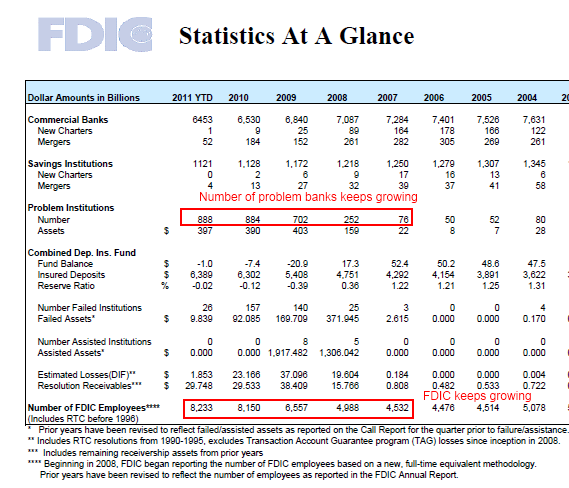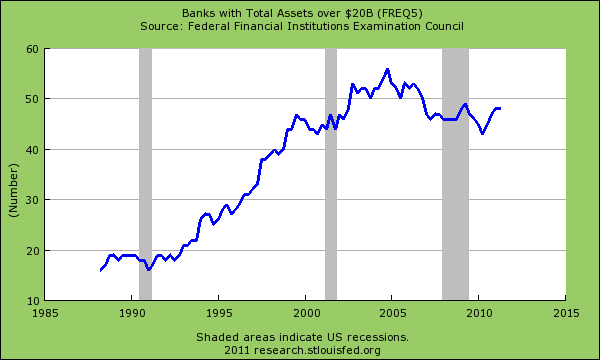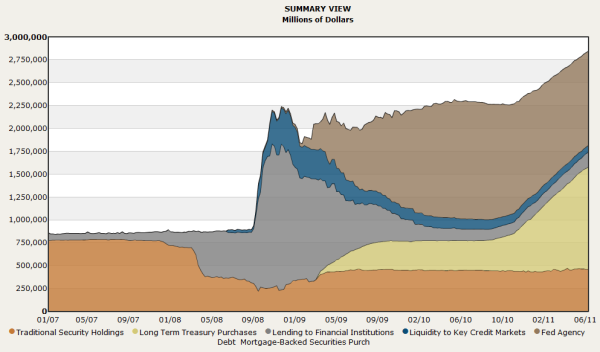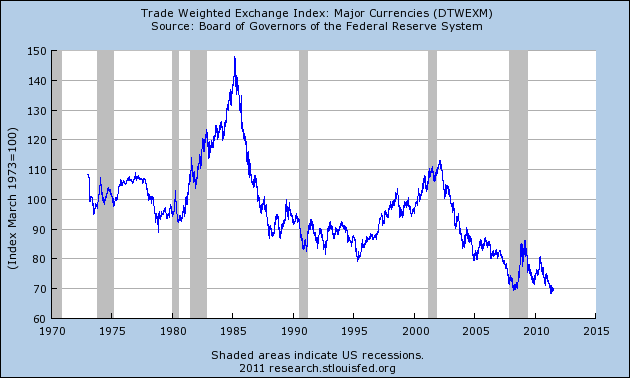A brave new banking system – while public is told banking system is healthy FDIC quietly grows troubled bank list by 180 and adds over 1,600 employees in the last two years to deal with bank failures.
- 1 Comment
The banking system in the United States rests on a very thin layer of faith and that faith has been shaken by the current financial crisis. The retail banking system is largely a facade that now latches on to taxpayer bailouts to fund speculative investments through their investment banking divisions. The repeal of Glass-Steagall has been an absolute failure for allowing this commingling of financial functions. I find it interesting that while we get a public stance that all is well on the banking front, we find that the FDIC keeps adding employees to handle bank failures and the number of problem institutions continues to grow. Of course this is the kind of information that is buried deep in websites and financial statements while most of the press focuses on distractions.
Why would FDIC keep expanding through recovery?
I was digging through FDIC data and found the below information rather enlightening. While we are told that the condition of our financial system is getting better, we find that the FDIC is adding more and more employees while the number of banks deemed “problems†continues to grow:
Source:Â FDIC
In the last two years the number of problem institutions jumped from 702 in 2008 to 888 currently. We have also added many more FDIC employees (from 6,557 to 8,233). What I find illuminating is that in 2007, at the peak of the credit bubble only 50 institutions were regarded as problematic. In other words, the main institution overseeing our banking system and deposits had no clue at the apex of the bubble that a problem was imminent. Should we now be surprised that we are told that banking conditions are healthy while the above data tells us a very different story?
Too big to succeed
In the 1990s we had anywhere from 20 to 30 banks with total assets larger than $20 billion. At the peak of the crisis we had closer to 55 but today we are nearly back to 50. The too big to fail banks have gotten even bigger. This was always an interesting argument taken by the financial sector. We were told that too big to fail was part of the problem and caused a systemic meltdown. The solution? Make the too big to fail even bigger. So it is no surprise that while the middle class becomes smaller and pays for the bailouts this select group of banks become even bigger and more profitable. The list of giant banks is troubling:
The Federal Reserve also continues to provide cover for these large institutions by allowing them to store toxic assets off their balance sheet in the heart of our central bank:
A whopping $2.84 trillion is stored in the Federal Reserve balance sheet. We have already shown the mixed bag of toxic assets here including commercial real estate loans, odd business loans, and of course large amounts of residential mortgages. How is this indicative of a healthy banking system? Is it any wonder why the U.S. dollar has done this over time?
It is unfortunate that our U.S. dollar is valued at the lowest level in four decades. But what do we expect with current banking policies and a government that has offered very little to the middle class for many decades? I don’t think this is a partisan battle. Frankly, both parties are beholden to the checkbooks of large financial institutions. On a bigger level, if we want politicians to represent the interests of the people without worrying about financing a campaign we should seek radical reforms in our political financing system. There is little desire to do this from Wall Street investment banks since their return on investment (ROI) has yielded a fantastic sum. Nothing better than guaranteed taxpayer money when all you have to do is funnel a tiny percentage of this back into the political machine every two years.
We need to bring Glass-Steagall back. We need to split commercial and investment banking once and for all. It is amazing that people think their money is safe when they are earning roughly 0 percent in a saving account while banks turn around and lend this money out for high interest rates or speculate in the stock market. Who wouldn’t love this deal? I’ll give you a giant loan at 0 percent and you go try to make some money. Only a central banker would make this kind of deal but it comes on the backs of the working and middle class.
The debt ceiling debate is comical in many ways. After decades of spending like maniacs we all of sudden want to find restraint especially after we’ve given the banking system trillions of dollars! First, the interest payments would skyrocket so right off the bat we would increase our own interest payments. Not smart at all. We need to be honest and like any household facing tighter times, we need to find more revenues and cut spending. That is the unfortunate reality. But more importantly we need to reform the financial system to keep the investment banks from pilfering the middle class any further. We are indeed facing a brave new banking world.
If you enjoyed this post click here to subscribe to a complete feed and stay up to date with today’s challenging market!1 Comments on this post
Trackbacks
-
therooster said:
Buy gold ! Why, you ask ? It’s a debt-free asset and nobody else’s liability …. unlike a Federal reserve note or some other paper promise.
July 13th, 2011 at 7:50 pm




 If you enjoyed this post click here to subscribe to a complete feed and stay up to date with today’s challenging market!
If you enjoyed this post click here to subscribe to a complete feed and stay up to date with today’s challenging market!